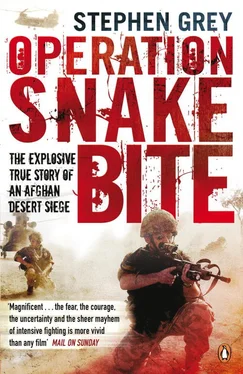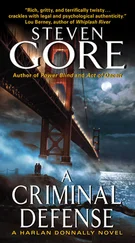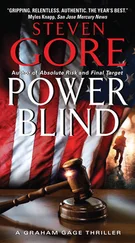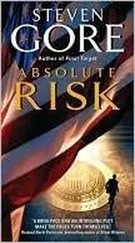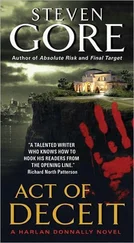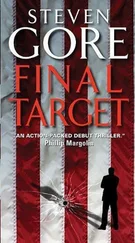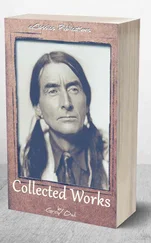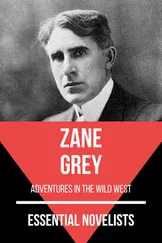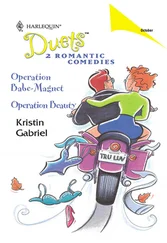The noise was phenomenal. Paul Britton and his mortar controller, Duncan Maddocks, were calling in a barrage of mortar rounds from Inkerman and preparing to bring in artillery. Apache helicopters were also inbound.
Then a flash and bang as another RPG arched down into a wall inside the compound. Shrapnel hit a signaller, Corporal Dave Watts, in the backside. It struck Britton in the arm and hand.
‘I knew there was something wrong with my arm,’ recalled Britton. ‘It hurt and then went numb. I looked across – I saw that my arm was still there, but I couldn’t really move it.
‘People had jumped on to Corporal Watts because it was obvious he was quite badly injured.’ No one noticed Britton had been hit. Britton went up to Maddocks, who was talking on the radio.
‘My arm!’
Maddocks didn’t even look at him; just raised his hand to say he was busy. Britton repeated: ‘No, I want you to see my arm!’
Maddocks looked over. He saw the blood.
‘Oh yeah! Your arm!’
He dropped the handset and ripped off Britton’s T-shirt and put a dressing on. It felt a lot better and tighter now, but Britton still could not move it. He did not even spot the shrapnel that had gone into his hand. Maddocks offered Britton morphine, but he refused. He had to keep his mind straight.
Ogden had seen Watts drop and he sped across, worried that shrapnel could have severed an artery, but Watts seemed more concerned about his manhood. Ogden checked it out and assured him everything was intact. He patched him up and gave him a cigarette.
By now, it was clear the injured needed a helicopter medevac. Urgently. With so much blood loss from Fletcher and Greening, it would take too long to get them back to the landing site at Inkerman.
Outside the compound, the 2 Troop machine-gunners were running out of ammo. Jim Wright, the troop sergeant, called men forward to resupply with chain-links of bullets wrapped round their shoulders like Rambo.
One of them, instead of using the bridge over the ditch, ploughed into the river, which went up to his neck. Wright thought he had seen the last of him. But he came out the other side crawling towards them like a cat. It all seemed in slow motion. ‘This is fucking surreal,’ thought Wright. Meanwhile, the sergeant-major, Brownrigg, had the task of securing a helicopter landing site. He and 1 Troop started flanking through the thick maize to get to the rear of the compound. The rounds came buzzing through. They couldn’t see the enemy. All they could do was use their ears to work out where to fire back at.
The initial attack had been mainly from the east, but the Taliban had flanked now round to the west. And when 1 Troop came out of the maize into open ground again by the planned landing site, they found the Taliban were firing from the south too, from barely 100 yards away.
Two Apaches were now on station and blazed at the tree lines with cannon, rockets and Hellfire missiles. At 16.45, Alpha Company reported the landing site was secure.
It was time to quit the compound, avoiding the fire-raked entrance. A Gurkha engineer tried to crowbar through a wall but gave up. Instead he got out a stick of explosive and blew a ‘mouse-hole’ through. Fenwick, the injured marine, was told to move. When he got to the wall, he found it was only a tiny hole. ‘Oh my God, I’m not going to get through,’ he thought. The marines bashed away some more of the mortar, and he managed to squeeze through.
The last to leave the compound was the air controller, Sergeant Michael Garth. With his headphones on he seemed oblivious and was walking, said one marine, ‘like nothing was going on, because obviously he was in the middle of telling lies to the AH [Apache helicopters]’. Precise records of what exactly was said to the helicopters were not revealed. But legend has it that Garth, in something of an understatement, told the Apaches the landing site was as ‘secure as it will be’, and the full meaning of that message never quite made it to the rescue Chinook.
Just before the Chinook came in, Brownrigg saw an Apache hovering over FOB Inkerman and just twirling around and pouring fire from its cannon. Brass shell casings rained down beneath. All at the same time, mortars were whistling down; and shells from Inkerman’s battery of three 105mm artillery guns shrieked across and exploded with a whumph . Soldiers watching from the base thought it was like a scene from Apocalypse Now .
For the past half hour, the Chinook had been circling in the desert near by. At the controls was a Royal Navy pilot, Flight Lieutenant Nichol Benzie, with RAF co-pilot Flight Lieutenant Al Sparks. The pilots had no direct contact with the marines. Sergeant Garth was speaking to the Apaches. And the Apaches spoke by secure radio to the crewmen in the back of the Chinook. And the crewmen relayed the message by intercom to the pilots.
‘When you’re getting stuff relayed like this, it’s a bit like Chinese whispers,’ said Sparks. ‘It gets a little diluted.’ He was on his first tour of Afghanistan. He was feeling pretty wide-eyed. Sometimes it was just as well the information was filtered.
When they got the call that the landing site was clear, the pilots still thought they were heading for FOB Inkerman. It was only when they got ‘in amongst the weeds’, flying ‘ultra-low’, said Benzie, that they noticed orange smoke rising in the green zone itself. They took a deep breath. There was almost no protection from gunfire there.
They were coming in fast and had to stop abruptly to get the helicopter down in a small field. As the pilots looked out, they could see guys on the ground tucked into the firing positions. If, like now, no one was looking at the chopper, that meant trouble. ‘The more we looked out,’ remembered Benzie, ‘the more we realized we should lean back and benefit from the Kevlar protection that the aircraft has to offer.’
In the back, crewman Sergeant Scott Todd saw the first casualty – Fletcher – approaching. ‘He was losing a lot of blood. I thought it strange straightaway that the casualty was in a poncho, which is like an emergency battlefield stretcher. It means pretty much you’re close to the fire fight.
‘I was shouting with adrenalin as well, trying to get the guys in fast because the guys in the front were saying, “How long?” I was just trying to call out an estimated time and shouting to the troops to hurry up, to double it.’
They lifted the casualty over the M60 chain-link machine gun on the ramp and, when Todd went back, he found a solid blood trail over his gun. ‘So I knew he was losing blood fast.’
Kneeling in the field, Ogden, the medic, had been preparing the casualties. Looking up as the ramp dropped, he could see the crew had no idea what they had landed into.
‘When the Chinook came in, as the back door dropped down, the “doc” [a medic] ran off, all springy and bouncy. As he came out to us a load of bullet rounds came past us. He just seized up. I think it was his first time being shot at. Obviously he tried turning back around towards the helicopter! So I dragged him back and held him. He was listening but not registering.’ Ogden handed him a piece of paper where all the conditions of the casualties were written down. ‘Eventually he just ran on the back again.’ The Chinook pulled away in a choke of boiling dust.
Alpha Company still had to get back home. They moved back in a rolling barrage of white smoke from mortars and high explosive from artillery. Even so, at 17.50, their rear was attacked as they neared the base.
Finally a Dutch F-16 dropped a 500-pound bomb, and after that it went quiet. There had not been a break in the fight for two hours. The Apaches were still circling and watching to see if anyone was following them.
Читать дальше
